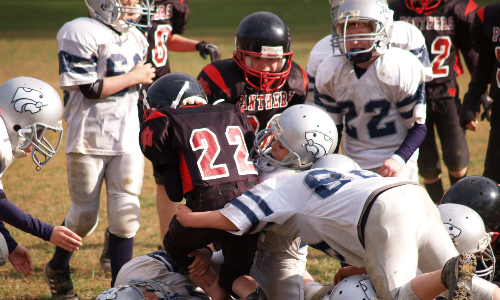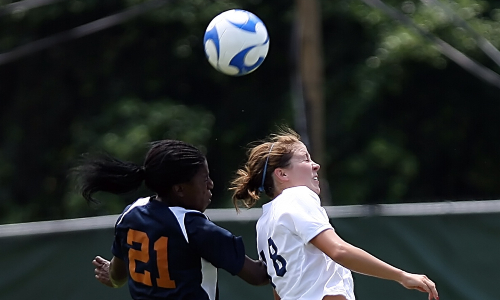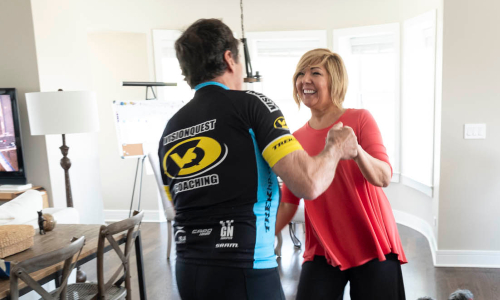RESOURCE CENTER
Subconcussive Impacts
The driving force behind Chronic Traumatic Encephalopathy (CTE)
Many people are surprised to hear that there have been cases of CTE discovered in athletes who have never been diagnosed with a concussion. This revelation has spurred some scientists to look at other types of brain trauma as a possible cause of CTE. Currently, the best available evidence suggests that subconcussive impacts, not concussions, are the driving force behind CTE.

What is a subconcussive impact?
To understand what a subconcussive impact is, we first need to understand what a concussion is.
Simply put, concussions are the hits to the brain that cause symptoms. Concussions have symptoms because the brain is shaken violently enough that brain cells are damaged to the point where they don’t work properly. Subconcussive hits are those that are below that concussion threshold: the brain is shaken, but not so violently that the damage to brain cells is severe enough to see through symptoms.
Examples of these types of impacts include most tackles and collisions on the football field; headers in soccer; checks or collisions with the boards or other players in ice hockey; and body checks in lacrosse. The impacts are there, and the brain is affected, we just don’t notice it right away.
You can think of CTE like an overuse injury. Baseball pitchers who throw too much eventually might need “Tommy John surgery” due to all the microtrauma that leads to wear and tear on a ligament in their elbow. They never had a big injury to the elbow, but it wore out all the same. CTE may be occurring the same way – it’s not a single injury that causes the disease, but instead accumulation of microtrauma from thousands of hits over years. The big difference is that we’ll never have a surgery that will fix your brain, so it’s important to try to prevent CTE by limiting exposure to head impacts – just like pitch counts in baseball help prevent elbow injuries.
How do we know subconcussive impacts are dangerous?
In the last several years, research groups using helmet-mounted accelerometer devices have helped us understand how subconcussive impacts add up to brain damage. This technology allows scientists to count how many hits an athlete takes over a period of time, how hard the hits are, and how much rest an athlete gets between hits. Scientists can use this information to compare athletes with lots of hits to athletes with fewer hits, or to people who haven’t been hit at all.
Another benefit of this type of research is that it allows scientists to take out athletes who have had concussions, allowing them to focus only on the effects of subconcussive impacts. By comparing athletes with lots of hits to athletes without hits, scientists can isolate the effect that hits have on a variety of different things, from an athlete’s memory and thinking ability to the strength of the physical connections in the brain. The picture is pretty clear: too many hits is not a good thing. Here’s what we have learned:
Subconcussive hits hurt our memory and attention.
Several studies have shown that athletes who suffer more subconcussive impacts do worse on memory and attention tests than their teammates who suffer fewer hits.
Subconcussive hits damage the connections in our brain.
Different areas of the brain are interconnected by bundles of wire-like brain cells, allowing them to seamlessly communicate. Using a technique called Diffusion Tensor Imaging (or DTI), scientists can see these connections, and measure their structural strength. Too many subconcussive impacts can damage the structure of these wiry connections, making it harder for brain areas to communicate.
Subconcussive hits suppress brain function.
Using a technique called functional magnetic resonance imaging, scientists can see how active different brain areas are during thinking or memory tasks. Studies in contact athletes have shown that athletes with more subconcussive impacts have less brain activity than athletes with fewer impacts.
Subconcussive hits may contribute to later life mood and behavior problems.
Since we’ve only been able to accurately count subconcussive impacts for the last 10 years or so, we’re still in the early stages of understanding what the long-term consequences of these injuries are. The athletes in the first hit-counting studies just aren’t old enough yet to have developed long term problems.
Some researchers have found a clever way to estimate how many hits someone took over their athletic career, offering us a window into what may be in store for athletes today. By cataloging the positions that each athlete played throughout their career, scientists could estimate how many hits athletes took based on how many hits those playing the same positions take today. Their findings are consistent with the rest of the research on subconcussive blows: the athletes who took more were at greater risk for mood and behavior problems later in life.
How can we prevent subconcussive hits?
Limiting subconcussive impacts is a great way to make sports safer. At the Concussion Legacy Foundation, we advocate for three pillars to reduce the number of subconcussive impacts athletes are exposed to.
Delay the introduction of contact (age-appropriate rules):
Athletes who have longer careers in contact or collision sports suffer more subconcussive impacts, and athletes who start earlier tend to have longer careers. By delaying the introduction of contact or collisions (through rule changes for youth divisions), we can limit the time an athlete has to accrue damage.
Eliminate contact where unnecessary.
Research using Hit Counting devices has shown that in many sports, the majority of head impacts occur during practice. By altering drills and practice structure to eliminate contact when it is not completely necessary, we can chip away at the lion’s share of subconcussive hits in sports without changing gameplay at all.
Modify contact where appropriate.
Some practice contact is necessary for athletes in contact and collision sports to learn how to protect themselves and their opponents from serious injury. In these cases, limiting the repetitions to the minimum necessary to achieve particular learning points is a great way to prevent needless injury. A thoughtful approach to drills and practices can go a long way!
Learn more about our education and advocacy programs designed to prevent subconcussive hits.

You May Also Like

Although we cannot yet accurately diagnose CTE in living people, a specialist can help treat the symptoms presenting the most challenges.
CTE Treatments